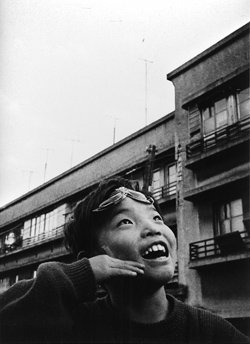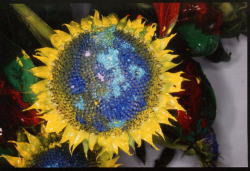Nobuyoshi Araki (photographer and a contemporary artist, born 1940 in Tokyo)
Aomi Okabe: Around what time do you take photographs for Hitozuma Eros (Eros of Married Women) series? Do you give instructions to what the models wear and how they apply their makeup?
Nobuyoshi Araki: It takes about three hours, starting from 14:00 to 17:00. During this time the effect of strong lighting creates an extraordinary experience. The best environment is to let models do whatever they want with both makeup and clothes. I don't try to take good photographs, but simply take shots continuously when models are standing right there. I may casually take photos of three models in a day by with color film, while with a monochrome film I take nude shots without capturing their faces, praising their ugly bodies. So I am betraying them. And that made the photo book of Uragiri (Betrayal), the selection of one hundred nude shots of married women.
Okabe: There must be quite a few professional models you work with by now.

Nobuyoshi Araki photo:okabe aomi
Araki: There are no professional models. A model must be a person who has a life of his or her own. Students are the worst, they aren't interesting at all. On the other hand, ‘married women’are professionals, right? Women who work in sex industry are also professionals too. It must be people who do these kinds of things to live, as a career.
Okabe: Your photo books always have good titles and catch-phrases, it's may be because you have an intelligent mind. What sort of management are you and your two staffs like Mr.Tamiya involved in at your office, AaT ROOM?
Araki: Well it’s not a case of brains. There used to be a workshop school for photography and those guys were my students, they were also the first graduates of the school. They're about fifty years old now and even though they themselves take photographs, they say they would rather follow me to the grave. When a photographer takes photos for a magazine, it's for money. What is more important is the time when we give money away. Everything should be a matter of personal concern, a love.
Okabe & students: Everything is a matter of love!? You've mentioned your best selling photo books are Sentimental na Tabi - Fuyu no Tabi (Sentimental Journey - Winter Journey), and Itoshi no Chiro (Chiro My Love). How many subscribers do those books have?

Nobuyoshi Araki"Sentimental na Tabi" Shinchosha, 1991
© Nobuyoshi Araki
Araki: Satchin is my bestseller. My photo books used to sell about ten thousand copies, you know. Nowadays, we can only publish two thousands in each edition, due to the economic recession. But Satchin has guts, it has been reprinted up to 12 editions. There are photo books like Satchin which have a legacy. On the other hand, there are books that capture the women of that time, which only last a short while. That's the difficult part.

Nobuyoshi Araki "Satchin" Shinchosha, 1994
© Nobuyoshi Araki
Okabe: Do erotic series from your photo collections sell well?
Araki: Yes, but not forever. They won't last long; you can't get books like Erotos now, even if you want to.
Okabe: Your style of photography is particular, for example to bind a woman with ropes on top of her heavy kimono. It seems very hard to prepare such an environment with all the makeup, kimonos, tools and equipment. Meanwhile, natural nude shots without any makeup or embellishment seem to be popular among people these days.
Araki: A photographer like Kishin Shinoyama deliberately uses a digital camera for its effect, calling his series “bright nude”. Since a digital camera cannot capture darkness, it changes it to lightness. He uses this mechanism to say "people of our times are as such", so on and so forth. He isn't attempting to bring out eroticism or anything, but questions what is our current era like? But you shouldn't change yourself just because the times have changed. Despite of this “bright time”, we have to express the wetting.
Okabe: You mentioned that Japanese men don't buy photographs with bondage ropes, but they sell very well in foreign countries, right?
Araki: Oh yes, the difference is terrific. Photographs of men and women abroad are like sports photographs, sports photos don’t sell, meanwhile bondage pictures don't have a market in Japan. People in Japan won’t buy photos for two or three hundred thousand yen anyway. But recently there are weird young people buying such expensive prints.
Okabe: I assume the market cannot be that big in USA, Canada, and Australia for instance.
Araki: No. It's because USA has all the world’s county bumpkins. Even if I manage to show my photographs there, their choices of exhibitions are different. They choose photos that capture a plain theme like the sky, which is boring. You should show everything, both pureness and dirtiness.
Okabe: In Hara Museum of Contemporary Art and Museum of Contemporary Art Tokyo, you exhibited polaroids, including some erotic photographs.
Araki: The trouble comes after I exhibited them. Curators were being called by the police. Curators are laying their lives on the line.
Okabe: From an early stage I saw your large scale eccentric erotic photographs which were exhibited abroad. I remember the exhibition in Museum of Modern Art, Frankfurt was quite awesome. There were photographs exhibited on the wall of central stairway, and a boy was asking his father what the pictures were about. The father was explaining it very calmly to his boy.
Araki: Yes, such scenes are so normal abroad. When I had an exhibition in Secession at Vienna, there were students visiting as an after-school program. They showed photographs of bondage ropes and penises to elementary kids without hesitation. They have a place for art in education. We can’t imagine this in Japan.
Student: I was shocked when first I saw Shikijoka (Lust Flowers). I even cried. Those colors have startled me.
Araki: I painted the flowers in Shikijoka. Lust Flowers in the Sky over the Balcony was a view of the sky from my house, but it turned to be "death sky" since Yoko's death weighed heavily on my mind. It was almost like dedicating flowers to her. There are always life and death, truth and false, and they need to be mixed up. This mixture also represents myself. Someone who does something important, no matter if he is a photographer or not, ought to have both sadistic and masochistic sides. He has to be androgyne, a person with both characteristics of man and woman.

Nobuyoshi Araki "Shikijoka" , 2003
© Nobuyoshi Araki
Okabe: You have been collaborating with intelligent woman like Taeko Tomioka.
Araki: Intelligent women are the only kind of women I want. Communications and relationships are never interesting if she has no intelligence. There's no point in studying though, because it is a natural talent. Women have to be smart. There's a touch between intellectual matters, a sex of intelligence. Hm, it's getting complicated.
Okabe: Since you are a judge in Canon's "New Cosmos of Photography", don't you think there are more women getting awards lately?
Araki: Yes. It's not that girls are more suitable for photography, but photographs are physiological materials from the beginning. It's different from the time when war was going on when reporting was for men, considering the need of physical strength. Now, videos are better medium for reporting. Photography is enough for little things, it is very unique. I always say "Women make good photographers, and men should carry the tripod". After I got to sixty I began taking the series of Nihonjin-no-kao (the face of Japanese people). But only a person who is able to see things beyond someone's face can do such work. An uninteresting picture tells the same about the photographer. Photographs are very honest, they are about exposing oneself in the end.
Okabe: I agree. Photographs clearly represent one's intuition and insight.
Araki: Plus how the photographer feels toward the object. A photographer needs to change his camera depending on what sort of picture he wants to take. I'm thinking to use a Leica from next year to take something large, not necessary a human's face. If you want to take pictures of life, Leica is it.
Okabe: You are a prolific photographer but you seem quite conscious of Hokusai.
Araki: I'm not being consciousness about him, but I just feel "This is Hokusai" or "This is Shiko Munakata" time to time. The exhibition of Munakata, at The Bunkamura Museum of Art, was interesting. The circle of Munakata amazed me. I take photos of pregnant women because the most beautiful curve of a woman is the "circle"; the vein protruding pregnant belly.
(At Shinjuku, December 12th, 2003, translated by Moeko Ogawa, revised by Emma Ota)
荒木経惟 アーティスト
岡部あおみ:『人妻エロス』の撮影は何時頃が多いのですか。着付けや化粧も指示なさるのでしょうか。
荒木経惟:午後2時から午後5時と3時間くらいね。大きいライトを当てた効果で、非日常の経験が出来るから。一番いいのは、自分でメイクして、服装のセンスもその人が表現してるってこと。上手く撮ろうとかじゃなくて、そこにポーンといて、一気に撮る。カラーで淡々と一日に3人撮ってる脇で、モノクロのフィルムを入れたカメラで、顔カットしちゃって、醜い肉体を「きれい、きれい」っつって顔なしヌードも撮ってる。裏切ってるわけさ。それが人妻ヌード100選の写真集『裏切り』なのね。
岡部:今は、プロのモデルさんもかなりいらっしゃるのでしょうね。
荒木:モデルのプロはいないよ。自分の生活を持ってる奴じゃないとだめ。学生は一番だめ、おもしろくない。「人妻」ってプロだろ。あとソープ嬢も。生きるため、職業としてそれをやってる人じゃないとね。
岡部:荒木さんの写真集はタイトルやコピーがいつも上手ですが、ブレーンがいいのかな。Aat Roomという荒木さんの事務所には、田宮さんなどスタッフが2人いて、どんなマネージメントしているのですか。
荒木:ブレーンなんていないよ。昔、ワークショップ写真学校があって、あいつらはそのときの俺の生徒で一期生。もう50歳ぐらいで自分でも写真撮ってるけど、俺に殉死したほうがいいって付いてきてる。頼まれて雑誌でやる写真はお金のためだろ。金捨てるときのほうが大切。私事(しごと)だよ、恋愛、全部。
岡部・学生:全部恋愛?!荒木さんの写真集で一番売れてるのは『センチメンタルな旅・冬の旅』とか『愛しのチロ』だとおっしゃってましたね。どのくらいの部数ですか。
荒木:一番は『さっちん』。アタシの写真集、前は1万部からだったね〜。今は景気悪いから増刷しても2000部くらいしかやれないよ。それでも大変、12刷だし。いい根性してる。永続性じゃないけど『さっちん』みたいにずうっともつのと、その時期の女の写真とか、すぐとまっちゃうのとある。そこがむずかしい。
岡部:今までの写真集の中で、エロティックシリーズはよく売れるんですか。
荒木:ずっとは無理だね。短いよ。でも『エロトス』なんて欲しくても手に入らない。
岡部:荒木さんは写真のスタイルとして、例えば重たい着物を着て、緊縛で撮るという方法に、すごく凝っていますよね。化粧、着物、小道具などの装置や環境をそろえるのがまず大変。最近は一般にお化粧もしないようなナチュラルヌードが流行っているようにも思えますが。
荒木:篠山紀信なんかは「アカルイハダカ」とかいって、わざとデジタルカメラでやる。デジタル使うとね、闇が写らない。闇が明るくなっちゃうだろ?それを利用して「現代の奴らはそうだ」っつってやってるわけ。自分のエッチをだそうとかいうんじゃない。「時代が何だ」とかね。でも時代がだめになっていくから、それに合わせようなんて、だめなんだと。そういう時代だからこそ、ここで湿りっ気出さなきゃ。
岡部:緊縛写真は、日本の男性は買わないっておっしゃってましたけど、外国では売れてますよね。
荒木:すごいよーもう。だって向こうの男女の写真はスポーツみたいじゃない。スポーツ写真は売れない。縛った写真は、日本では市場がない。それに昔から写真なんて日本では20万、30万円では買わないよ。最近は変な若いのが、一生懸命プリントを買ったりさ、流行ってるけどね。
岡部:海外といってもアメリカ、カナダ、オーストラリアとかは少ないでしょうね。
荒木:だめだよ。アメリカは世界のいなかっぺが集まっているから。出せても選ぶ出し物が違う。空だけとか地味なのが多い。それはつまんない。ピュアなものと濁ったものと、全部見せて、汚れも見せないと。
岡部:原美術館や東京都現代美術館でポラロイドでしたが、エロティックな写真も展示してましたね。
荒木:出しても後がたいへん。学芸員がちゃんと警察署に呼ばれてる。学芸員は体張ってんだよ。
岡部:荒木さんの非常にきわどいエロティックな大型の写真を、私はかなり早い時期から海外で見ていて、フランクフルト近代美術館などすごかった。中央階段の壁全面に貼ってあり、小さい男の子とお父さんが見に来て、「これなあに、お父さん」って質問してる。父親は全然動じず、平然と説明していました。
荒木:そう、向こうは平気でやってる。ウィーンのゼッツェッションで展覧会やったときなんて、課外授業に生徒を連れきて、縛った写真とかおちんちん出てるのを、小学生とか中学生とかにみせてる。教育の場所で、芸術、アートの時間なんだよ。日本とは全然そこんとこの期待がちがうんだよなー。
学生:『色情花』とか、びっくりしましたよ、泣きました(笑)。あの色彩に、ドキッとしました。
荒木:『色情花』は、花に色を塗ってる。『バルコニーの空に色情花』は、うちからの眺めの空なんだけど、彼岸で、死の世界、ひっかかってるのは陽子の死で、「死空」。花を捧げるっていうような感じ。いつも生と死があって、本当のことと嘘のこととかさ、まぜこぜにしないとね。そういうのがアタシ自身だから。それに写真家に限らず何かやる奴は、サドの要素とマゾの要素とどっちも持っていなくちゃいけないでしょ。おとこ性とおんな性と、両性具有じゃないとさ。
岡部:荒木さんは、富岡多恵子さんとかわりとインテリ女性とコラボレーションされたりしていますよね。
荒木:そりゃ女はインテリに限るよ。コミュニケーションや関係性は、知的感覚がないとおもしろくないんだよ。持って生まれたことだから勉強してもしょうがないんだけどね(笑)。やっぱり、頭良くないとだめね。知的なことでの接触っていうか、知の性行為。(笑)いやー、なかなか難しくなってきたぞー。
岡部:荒木さんは、キャノンの「写真新世紀」の審査員ですが、近年は女性がわりと賞とっていますね。
荒木:うん。女の子が向いてるって言ったらヘンだけどさ、もともと、写真って生理的なものなんだから。今まではずっと戦争の時代だから肉体の事があったりして、報道は男っぽいじゃない。今は報道ならヴィデオとかの方が武器としてはいい。写真なんてすごく小さなことでいい、もう特異だから。「写真家は女のほうがいい」、「男は三脚持ち!」って俺は言うの(笑)。還暦60歳になって『日本人の顔』シリーズ始めたんだけど、自分が相手の顔の奥まで見えるような人間になってこないとだめね。魅力ない写真は、撮った奴も魅力ない。それがでちゃう。写真はバレちゃう。結局自分をバラしてるだけなんだな。
岡部:そうですね。直観力、洞察力みたいなものがはっきり出る。
荒木:それから、相手に対してどういう気持ちになるかっていうことね。しかも写真はカメラで決まる。だから「荒っぽいものを撮るときはこれ」っていうようにカメラを変える。だから来年からはライカに絞っていこうかなと。人間の顔じゃないけど、もっと大きな何かね。人生を撮るにはライカ。
岡部:荒木さんは多作ということでも、北斎を意識してらっしゃいますよね。
荒木:意識じゃないよ、たまたま「あ、北斎だな」、「あ、棟方志功だな」っとかさ(笑)。Bunkamuraザ・ミュージアムで見た棟方の展覧会、面白かった。棟方志功の円に「おっ」となった。なぜ妊婦を撮るかっていうと、女性の一番きれいな曲線は「円」だから。青筋が出た妊婦の腹だよ。
(2003年12月17日、新宿)
